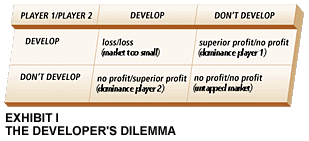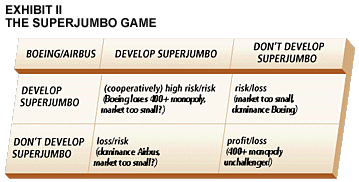Game Theory: The Developer's Dilemma, Boeing vs. Airbus
(originally published by Booz & Company)This may appear to be the ration-ale behind the Boeing Company's much-publicized cancellation of the development of its "superjumbo," a whole new class of aircraft with room for 500 to 1,000 passengers.
"The market isn't ready yet," announced John Hayhurst, general manager of Boeing's "superjumbo" project, early last year. According to a new Boeing study, customers choosing direct flights in smaller jets, avoiding the hubs of Singapore, London's Heathrow and New York's Kennedy International, were undermining the commercial viability of investments in super-large airliners -- investments that might well exceed $10 billion. Mr. Hayhurst estimated demand between 1997 and 2014 at below 500 craft, while Europe's Airbus Industry, Boeing's only remaining rival in civilian aviation, is still predicting sales of 1,400.
At the time, Wall Street was impressed with such measured prudence, awarding Boeing with an immediate jump of more than $7 in its share price. But was Mr. Hayhurst really addressing the financial markets?
As companies employ more and more sophisticated public relations methods, competition takes place increasingly behind a smokescreen. Appearances have become so deceptive that business intelligence itself is now a booming industry. Yet, in the time-honored tradition of Kremlin watching, even the best informants and the most plausible leaked documents may turn out to be part of a conspiracy ploy.
Simple game-theory tools can go some way toward restoring common sense. People in business may not mean what they say but, unlike the secretive rulers of the old Soviet Union, they mostly make sense. Though both Boeing and Airbus engaged in successive puzzling activities in the "superjumbo" game, they may reveal in the end a coherent set of motivations: With Mr. Hayhurst's announcement, Boeing played a psychological card in a game it recognized it could not win.
At the heart of the scenario is the Developer's Dilemma, a simple way to visualize investor choices when the market is unlikely to sustain rival investments. (This is a variation of the Prisoner's Dilemma, a game-theory model that has been around since the 1950's.)
Player 1 can choose between the two row strategies, player 2 between the two column strategies. Outcome of choices (= playoff) for player 1 is listed first.

In the Developer's Dilemma game, each player has two options, to invest in the development of a new product or not to invest. If only one of the players decides to develop, he will reap superior profits from unchallenged future market dominance. If both players go ahead, the product is likely to generate losses for both players. If neither goes ahead, a profitable market remains untapped. (See Exhibit I.)
This appears to be a plausible model of the strategic situation when Boeing and Airbus first envisioned jetliners with up to 1,000 seats. Development from scratch was projected at $15 billion, with a market capacity estimated to be well below 2,000 aircraft. Unsurprisingly, both companies sought to avoid the Developer's Dilemma by entering a strategic alliance designed to bundle resources in the development of a Very Large Commercial Transport (VLCT), as it became known. By cooperating, both players anticipated a profitable solution, reducing the risk that one or both of the companies would fail in the market altogether.
A joint team was set up in 1993, but several factors made cooperation difficult. With the Developer's Dilemma looming in the background, the threat remained that one of the parties would acquire the other's crucial technical expertise, develop an advantage and defect, going for outright dominance. This is a common problem facing alliances: how to make mutual assurances credible.
Airbus soon suspected that Boeing was not interested in making irreversible commitments. The reason was not that Boeing wanted to run away with outright domination of a new market, however, but rather that it sought to preserve its monopoly in the older market of aircraft with 400-plus seats by employing delay tactics. (Boeing's 30-year-old 747 jumbo design seats 420 people, while the largest Airbus, the high-technology, state- of-the-art A330, has a capacity of only 330.)

Under this interpretation, Boeing was not caught in the Developer's Dilemma in the first place, because an untapped new market meant monopolistic profits in the old. (Boeing makes $45 million on each $150 million jumbo it produces.) Airbus even claimed that high profits on jumbo sales allowed Boeing to subsidize sales of medium-size jets. In game-theory terms, Boeing's payoff for leaving the new market untapped was positive, Airbus's payoff was negative. Boeing's best interest was to slow development of other jets in the 400-plus category, while Airbus's interest was to end Boeing's jumbo monopoly. (See Exhibit II.)
In 1995, Airbus decided to go it alone. The VLCT was abandoned. Its successor became a 550-seat Airbus, called A3XX. Development costs were estimated at about $8 billion. Boeing countered by announcing a stretched double-decker jumbo, carrying 600 passengers with development costs of a mere $2 billion.
In game-theory terms, Boeing's response must be viewed as a threat, changing Airbus's potential payoff for developing an alternative 400-plus seater: If you (Airbus) go ahead, we (Boeing) will undercut you, using our existing designs. However, the threat, in the end, was called as a bluff. British Airways and Singapore Airlines, the two carriers relying most on overcrowded airports and anxious to add bigger craft to their fleet, rejected the existing jumbo's technology as outdated. This forced Boeing to revise its development estimates, first to $5 billion, then $7 billion.
As noted earlier, the consolidation of the jet aircraft industry has left just two major players, competing on a global basis. Such a competitive landscape clearly invites game-theory modeling, where decisions by one player are dependent on the moves expected of the other player.
Airbus remains a cumbersome consortium involving four parent companies in which several European governments, and therefore the taxpayer, have an important stake. This makes Airbus particularly vulnerable to psychological attacks (though it may succeed in transforming itself into a proper company before the turn of the millennium).
Boeing realized that if both players chose to develop a superjumbo, it might well lose. It therefore tried to change the game. Twice it failed. Delaying VLCT and threatening to undercut the A3XX did not deter Airbus's resolve. Last year's cancellation of its development project, heavily publicized in the global press and underpinned by elaborate arguments about changing consumer demands, may have been Boeing's last attempt. Industry analysts immediately put pressure on Airbus's four European partners, expecting the consortium to follow by canceling the A3XX. This, game theory predicts, is unlikely to happen.
In his cancellation announcement, Boeing's Mr. Hayhurst said this: "Airbus is going to have to address the same issues we did. What is the size of the market, what are the development costs and what is the revenue stream going to look like?" What Mr. Hayhurst really meant that day was: "We should not explore a potentially profitable market if that destroys us in another" and "We should prevent our competitor from moving into these markets." Perfectly good advice.
Bringing a new jet with 400-plus seats to the market is always a risky enterprise but, game theory tells us, it is far riskier for Boeing than for Airbus. ![]()
Reprint No. 98212

